Chlorhexidine vs. Chloroxylenol — What's the Difference?
By Tayyaba Rehman — Published on January 8, 2024
Chlorhexidine is an antiseptic effective against a wide range of bacteria, fungi, and some viruses, while Chloroxylenol is a disinfectant used for skin and surface sanitation.

Difference Between Chlorhexidine and Chloroxylenol
Table of Contents
ADVERTISEMENT
Key Differences
Chlorhexidine is an antiseptic agent known for its broad-spectrum efficacy against bacteria, fungi, and some viruses. It's commonly used in healthcare settings for skin disinfection and wound cleaning. Chloroxylenol, on the other hand, is a disinfectant that's effective against bacteria and some viruses, often used for skin antisepsis and household cleaning. It's a less potent antiseptic compared to chlorhexidine.
In terms of application, chlorhexidine is widely used in surgical scrubs, preoperative skin preparations, and oral hygiene products due to its strong antibacterial properties and ability to bind to skin and mucosa, providing lasting effects. Chloroxylenol, with its milder action, is found in household disinfectants, personal hygiene products like soaps, and in some wound-cleaning solutions.
Chlorhexidine is known for its residual activity on the skin, meaning it continues to provide antimicrobial protection after application. This makes it highly valued in surgical and dental practices. Chloroxylenol, though effective as a disinfectant, doesn't offer the same level of residual activity and is more suited for general sanitization purposes rather than critical antisepsis.
The formulations of chlorhexidine usually include its gluconate form, which is soluble in water and alcohol, making it suitable for various types of medical and dental products. Chloroxylenol is often combined with other compounds in cleaning products to enhance its efficacy and is favored for its lower toxicity and milder nature on skin and surfaces.
In terms of safety profile, chlorhexidine can cause skin sensitivity and, in rare cases, allergic reactions. Its use is carefully monitored in healthcare settings. Chloroxylenol, being milder, has a lower risk of skin irritation, making it a preferred choice in household cleaning products and less critical antiseptic applications.
ADVERTISEMENT
Comparison Chart
Antimicrobial Spectrum
Broad-spectrum against bacteria, fungi, viruses
Effective against bacteria, some viruses
Common Uses
Surgical scrubs, oral hygiene
Household disinfectants, personal hygiene products
Residual Activity
High residual activity on skin
Lower residual activity
Formulations
Often in gluconate form
Combined with other compounds for efficacy
Safety Profile
Can cause sensitivity, monitored use
Milder, lower risk of skin irritation
Compare with Definitions
Chlorhexidine
Preoperative Preparation: Used in pre-surgical skin preparations.
Surgeons use chlorhexidine solutions to prepare the operative site.
Chloroxylenol
Household Disinfectant: Used in cleaning and disinfecting products.
Chloroxylenol is a key ingredient in many household cleaners.
Chlorhexidine
Dental Hygiene Products: Used in oral rinses and toothpastes.
Chlorhexidine mouthwash is effective in reducing dental plaque.
Chloroxylenol
Lower Skin Irritation: Less irritating to skin than stronger antiseptics.
Chloroxylenol is suitable for frequent use in hand soaps.
Chlorhexidine
Residual Antimicrobial Activity: Continues to act after application.
Chlorhexidine provides long-lasting protection against infection.
Chloroxylenol
Mild Antiseptic: Less potent but effective for general use.
For minor cuts, chloroxylenol solution can be used for cleaning.
Chlorhexidine
Broad-Spectrum Antiseptic: Effective against a wide range of microbes.
Chlorhexidine is used in hospitals for surgical hand scrubs.
Chloroxylenol
Personal Hygiene Products: Found in antibacterial soaps and lotions.
Chloroxylenol soap is popular for its antibacterial properties.
Chlorhexidine
Skin Disinfection: Commonly used for skin and wound cleansing.
Before surgery, chlorhexidine is applied for skin disinfection.
Chloroxylenol
Surface Sanitation: Effective for sanitizing various surfaces.
In hospitals, chloroxylenol is used for cleaning non-critical surfaces.
Chlorhexidine
(pharmacology) A particular chemical antiseptic and bacteriostatic.
Chloroxylenol
(chemistry) A compound with the chemical formula C8H9ClO, commonly used in antibacterial soaps and toxic to fish.
Chlorhexidine
A long-lasting liquid antiseptic; used by surgeons to wash their hands before performing surgery
Common Curiosities
Can chlorhexidine be used for oral care?
Yes, it's effective in mouthwashes and dental products.
Can chloroxylenol be used on wounds?
Yes, for minor wounds, but it's not as potent as chlorhexidine for surgical uses.
Is chloroxylenol safe for everyday use?
Generally, yes, due to its milder nature compared to stronger antiseptics.
Does chlorhexidine have long-lasting effects?
Yes, it binds to skin and mucosal surfaces, providing prolonged protection.
What is the main difference in use between chlorhexidine and chloroxylenol?
Chlorhexidine is primarily used for medical antisepsis, while chloroxylenol is used for general sanitization.
Is chlorhexidine suitable for all skin types?
Caution is advised as it can cause sensitivity in some people.
Is chloroxylenol effective against viruses?
It has some effectiveness, but not as broad-spectrum as chlorhexidine.
Can chloroxylenol be used in food preparation areas?
Yes, it's safe for cleaning surfaces in food preparation areas.
What are the typical concentrations of chloroxylenol in products?
Concentrations vary, commonly around 0.5% to 5% in household products.
How should chlorhexidine be used in healthcare?
It should be used as directed, particularly in preoperative skin preparations.
Are there any environmental concerns with these chemicals?
Both should be used responsibly to minimize environmental impact.
Can chlorhexidine cause allergic reactions?
Rarely, but it's possible, especially with repeated exposure.
Should chlorhexidine be rinsed off after application?
It depends on the product; some require rinsing while others are leave-on.
Can chlorhexidine be used on pets?
Yes, but under veterinary guidance, as pets may have sensitivities.
Is chloroxylenol found in hand sanitizers?
It's more common in soaps and lotions than in hand sanitizers.
Share Your Discovery

Previous Comparison
Seeds vs. Grains
Next Comparison
Moons vs. PlanetsAuthor Spotlight
Written by
Tayyaba RehmanTayyaba Rehman is a distinguished writer, currently serving as a primary contributor to askdifference.com. As a researcher in semantics and etymology, Tayyaba's passion for the complexity of languages and their distinctions has found a perfect home on the platform. Tayyaba delves into the intricacies of language, distinguishing between commonly confused words and phrases, thereby providing clarity for readers worldwide.












































